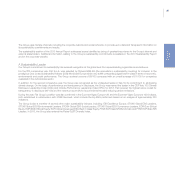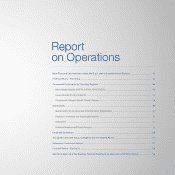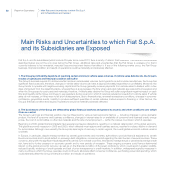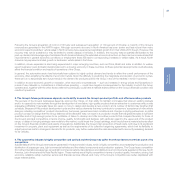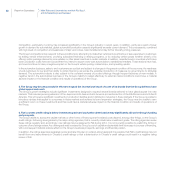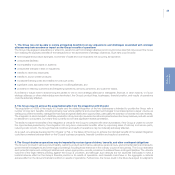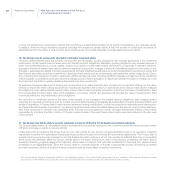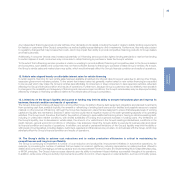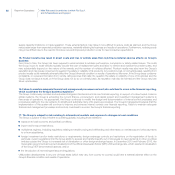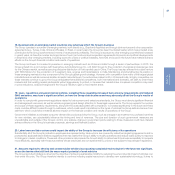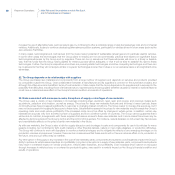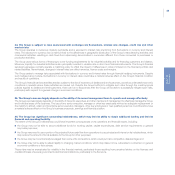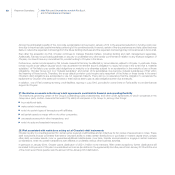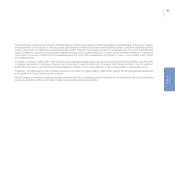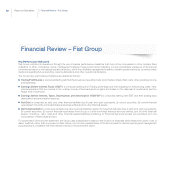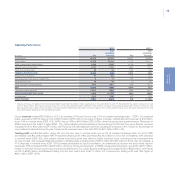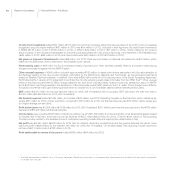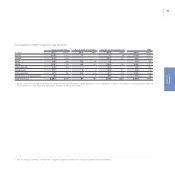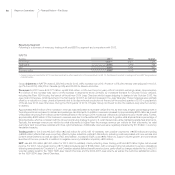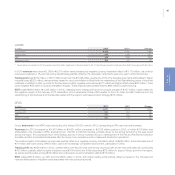Chrysler 2013 Annual Report Download - page 38
Download and view the complete annual report
Please find page 38 of the 2013 Chrysler annual report below. You can navigate through the pages in the report by either clicking on the pages listed below, or by using the keyword search tool below to find specific information within the annual report.
37
Report on
Operations
18. Developments in emerging market countries may adversely affect the Group’s business
The Group operates in a number of emerging markets, both directly (e.g., Brazil and Argentina) and through joint ventures and other cooperation
agreements (e.g., Turkey, India, China and Russia). In Brazil, in recent years the Group has been the market leader, which has provided a key
contribution to the Group’s performance in terms of revenues and profitability. The Group’s exposure to other emerging countries has increased
in recent years, as have the number and importance of such joint ventures and cooperation agreements. Economic and political developments
in Brazil and other emerging markets, including economic crises or political instability, have had and could in the future have material adverse
effects on the Group’s financial condition and results of operations.
The Group continues to increase its presence in emerging markets such as China and India through a series of partnerships. In 2013, the
Group entered into a joint venture with Guangzhou Automobile Group Co., Ltd (GAC Group) for the production of engines and passenger cars
for the Chinese market, as well as securing exclusive distribution of Fiat branded cars in China. The Group has also entered into a joint venture
with TATA Motors for the production of C-segment cars, engines and transmissions in India. Maintaining and strengthening its position in
these emerging markets is a key component of the Group’s global growth strategy. However, with competition from many of the largest global
manufacturers as well as numerous smaller domestic manufacturers, the automotive market, both in China and India, is highly competitive. As
these markets continue to grow, the Group anticipates that additional competitors, both international and domestic, will seek to enter these
markets and that existing market participants will act aggressively to protect or increase their market share. Increased competition may result
in price reductions, reduced margins and the Group’s inability to gain or hold market share.
19. Laws, regulations and governmental policies, including those regarding increased fuel economy requirements and reduced
GHG emissions, may have a significant effect on how the Group does business and may adversely affect the Group’s results of
operations
In order to comply with government regulations related to fuel economy and emissions standards, the Group must devote significant financial
and management resources, as well as vehicle engineering and design attention to these legal requirements. The Group expects the number
and scope of these regulatory requirements, along with the costs associated with compliance, to increase significantly in the future and these
costs could be difficult to pass through to customers, which could result in limitations on the types of vehicles the Group sells and where it can
sell them, which could have a material adverse impact on the financial condition and results of operations of the Group.
Government initiatives to stimulate consumer demand for products sold by the Group, such as changes in tax treatment or purchase incentives
for new vehicles, can substantially influence the timing and level of revenues. The size and duration of such government measures are
unpredictable and outside of the Group’s control. Any adverse change in government policy relating to those measures could have material
adverse effects on the Group’s business prospects, earnings and financial position.
20. Labor laws and labor unions could impact the ability of the Group to increase the efficiency of its operations
Substantially all of the Group’s production employees are represented by trade unions, are covered by collective bargaining agreements and/or
protected by applicable labor relations regulations that may restrict the Group’s ability to modify operations and reduce costs quickly in response
to changes in market conditions. These and other provisions may impede the Group’s ability to restructure its business successfully to compete
more effectively, especially with those automakers whose employees are not represented by unions or are subject to less stringent regulations.
21. Amounts required to develop and commercialize vehicles incorporating sustainable technologies for the future are significant,
as are the barriers that still limit the mass-market potential of such vehicles
The Group’s product strategy is driven by the objective of achieving sustainable mobility by reducing the environmental impact of vehicles over
their entire life cycle. The Group therefore intends to continue investing capital resources to develop new sustainable technology. It aims to


